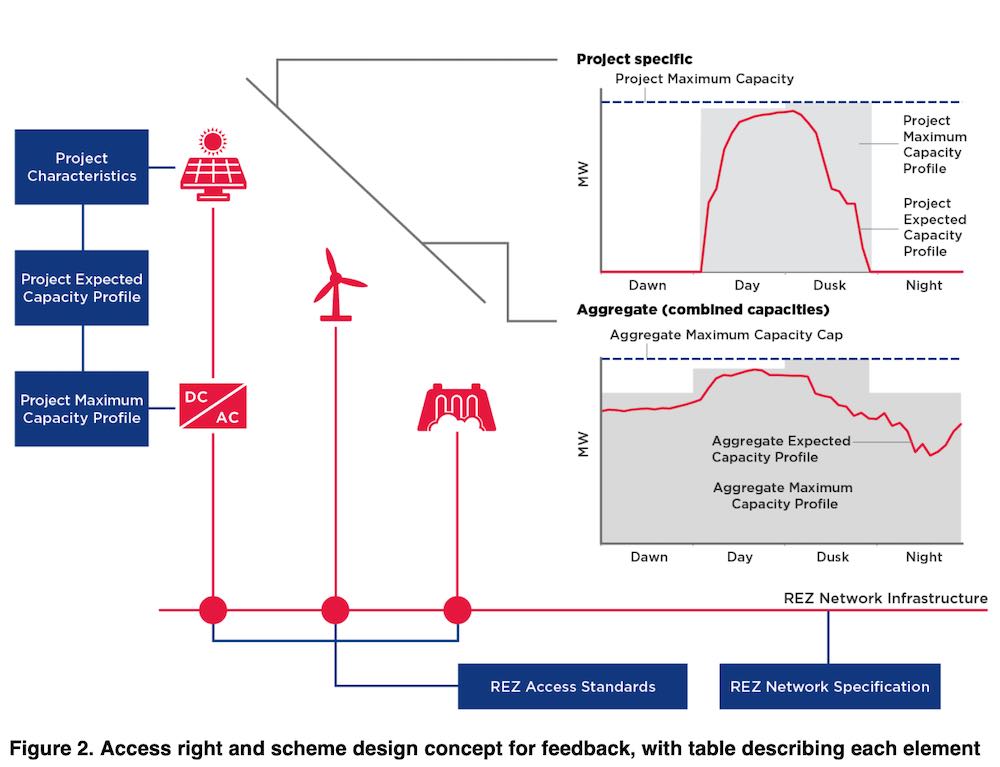The New South Wales government has put forward details of its plan to streamline and de-risk the connection of tens of gigawatts of new large-scale wind, solar and storage capacity in the state’s Renewable Energy Zones, starting with the 3GW expected to bid for a place in the Central West Orana REZ.
The NSW planning department has issued its thoughts on how the design might play out in the document REZ access rights and scheme design: Central-West Orana Consultation Paper and called for feedback on its proposals.
The 57-page design concept is intended to form the basis of all future REZs with elements that could be adapted to suit the individual characteristics of each of the state’s designated renewable zones.
It also aims to accommodate the impacts of meshed networks or multiple boundary points, the development of new transmission infrastructure, and different approaches to the roles of the REZ network operator and transmission network provider
The paper comes ahead of the tender for the state’s first designated REZ, which state energy minister Matt Kean said last month would attract at least 3,000MW of new renewable energy and energy storage capacity, along with $5.2 billion of new investment and 3,900 construction jobs in the region over the next decade.
All told, huge amounts of new renewables are expected to be contracted, constructed and connected between now and 2030, when the Perottet government is hoping to have added at least 12GW of additional capacity via the REZ tender process to replace most of the coal generators that will retire within a decade.
Crucially, the access right design aims to balance the need to provide new solar and wind projects with more certainty on their risk of “curtailment,” or having the amount of electricity they are permitted to send to the grid restricted.
Basically, it’s a way of getting wind and solar projects to pay for the right for a piece of real estate on the grid, in return for a guarantee that they won’t be crowded out, and subject to restrictions on their output.
As RenewEconomy has reported, curtailment has become a major deterrent to investors in Australia’s renewable energy market, with AEMO increasingly being forced to rein in generators on congested parts of the grid, often imposing limits on exports that had not been foreseen, nor factored into the economics.
This is something the NSW access right design hopes to minimise in the rollout of the state’s REZs, by actively coordinating network, generation and storage investment, and using up-front planning to support local outcomes.
“The access right is intended to provide generators with a better ability to forecast National Electricity Market locational price signals such as marginal loss factor and curtailment,” the paper says.
“It also aims to provide greater certainty around connection standards, processes and the timing of connection.
“The access right is not intended to remove locational price signals for generators, but rather to give projects enough information to accurately assess these risks, and to limit new connections where the target transmission curtailment is exceeded.”
The paper explains that the overarching goal of the access right concept is to identify the efficient usage of the transmission asset and in the process set a target transmission curtailment level.
Another key part of the process will be to set an Aggregate Maximum Capacity Cap, expressed in megawatts, that is an initial limit on the allocation of access rights within certain areas and zones.
According to the paper, the Aggregate Maximum Capacity Cap, along with the Aggregate Expected Capacity Profile, are set with the intention of not exceeding the target transmission curtailment level.
Projects will also be allocated a maximum capacity for each of four periods throughout the day – dawn, day, dusk and night – with the four maximum capacities being the Project Maximum Capacity Profile and the Aggregate Maximum Capacity Profile for all projects in a REZ being equal to or less than the Maximum Aggregate Capacity Cap.
The Maximum Aggregate Capacity Cap can only be revised – that is, additional access rights issued – if the target transmission curtailment level is not forecast to be met, for example where the network is augmented to increase its carrying capacity.
Essentially, the department is proposing that access rights will be provided in three allocations that optimise consumer outcomes and meet the following policy objectives: provide sufficient certainty to proponent generators; ensure efficient utilisation of the REZ; support the ability for proponents to fund augmentation of the REZ.
The paper also notes that large-scale energy storage projects, while themselves likely to improve the efficient utilisation of the REZ and reduce solar and wind curtailment risk, will be required to hold an access right to connect to the a REZ network.
“This allows for EnergyCo NSW and the AEMO Services to assess its impact (including system strength) on other projects appropriately,” the paper says.
Load, however, such as industrial facilities or hydrogen projects, will not be required to hold an access right or be charged an access fee, and should be encouraged to directly connect to New REZ Infrastructure to maximise the utilisation of the REZ and reduce curtailment risks.
In other words, load will be permitted to connect to a REZ network under current network access arrangements and will need to meet the same technical requirements as load connecting to other parts of the NSW transmission system.










